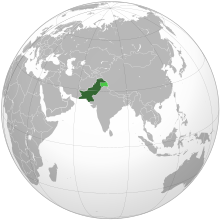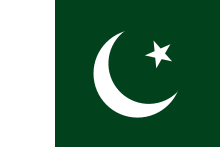ପାକିସ୍ତାନ


ପାକିସ୍ତାନ (ପାକିସ୍ଥାନ ନାମରେ ମଧ୍ୟ ଜଣା, ଉର୍ଦ୍ଦୁ: پَاکِسْتَان [ˈpaːkɪstaːn]),[a] ସରକାରୀ ଭାବେ Islamic Republic of Pakistan (ISO: ଉର୍ଦ୍ଦୁ: اِسْلامی جَمْہُورِیَہ پَاکِسْتَان, islāmi jamhūriyāh pākistān)) ଏସିଆର ଏକ ଦେଶ । ୨୪.୧୫ କୋଟି (୨୪୧.୫ ନିୟୁତ) ଜନସଂଖ୍ୟା ବିଶିଷ୍ଟ ଏହି ଦେଶ ବିଶ୍ୱର ପଞ୍ଚମ ସର୍ବାଧିକ ଜନସଂଖ୍ୟା ବିଶିଷ୍ଟ ଏବଂ ୨୦୨୩ ସୁଦ୍ଧା ଏଠାରେ ବିଶ୍ୱର ସର୍ବବୃହତ ମୁସଲମାନ ଜନସଂଖ୍ୟା ରହିଛି ।[୧] ଇସଲାମାବାଦ ଦେଶର ରାଜଧାନୀ ହୋଇଥିବା ବେଳେ କରାଚୀ ଏହାର ସର୍ବବୃହତ ନଗର ଏବଂ ଆର୍ଥିକ କେନ୍ଦ୍ର ଏବଂ ତା' ତଳକୁ କ୍ରମାନ୍ୱୟରେ ଲାହୋର, ଫୈସଲାବାଦ, ମୁଲତାନ, ପେଶାୱାର ଏବଂ ହାଇଦ୍ରାବାଦ ଆଦି ନଗର ଅଛନ୍ତି । 881,913 square kilometres (340,509 square miles) ପରିବ୍ୟାପ୍ତ ପାକିସ୍ତାନ ହେଉଛି ବିଶ୍ୱର ୩୩ତମ ବୃହତ୍ତମ ଏବଂ ଦକ୍ଷିଣ ଏସିଆର ଦ୍ୱିତୀୟ ବୃହତ୍ତମ ଦେଶ । ଏହାର ଦକ୍ଷିଣରେ ଆରବ ସାଗର ଏବଂ ଓମାନ ଉପସାଗରରେ 1,046-kilometre (650-mile) ସମୁଦ୍ରତଟ ରହିଛି ଏବଂ ଏହାର ପୂର୍ବରେ ଭାରତ, ପଶ୍ଚିମରେ ଆଫଗାନିସ୍ତାନ, ଦକ୍ଷିଣ-ପଶ୍ଚିମରେ ଇରାନ ଏବଂ ଉତ୍ତର-ପୂର୍ବରେ ଚୀନ ଅବସ୍ଥିତ । ଉତ୍ତରରେ ଆଫଗାନିସ୍ତାନର ୱାଖାନ କରିଡରଦ୍ୱାରା ତାଜିକିସ୍ତାନଠାରୁ ଏହା ଅଳ୍ପ ଦୂରରେ ରହିଛି ଏବଂ ଓମାନ ସହିତ ଏକ ସାମୁଦ୍ରିକ ସୀମା ମଧ୍ୟ ରହିଛି ।
ପାକିସ୍ତାନ ଅନେକ ପ୍ରାଚୀନ ସଂସ୍କୃତିର ସ୍ଥାନ । ଏଠାର ବେଲୁଚିସ୍ତାନସ୍ଥିତ ମେହେରଗଡ଼ରେ ୮୫୦୦ ବର୍ଷ ପୁରୁଣା ନିଓଲିଥିକ ସ୍ଥାନ,[୨] ବ୍ରୋଞ୍ଜ ଯୁଗର ସିନ୍ଧୁ ସଭ୍ୟତା[୩][୪] ଏବଂ ପ୍ରାଚୀନ ଗାନ୍ଧାର ସଭ୍ୟତା ଅନ୍ତର୍ଭୁକ୍ତ ।[୫] ଆଧୁନିକ ପାକିସ୍ତାନରେ ଅନ୍ତର୍ଗତ ଅନେକ ଅଂଶ ଏକାଧିକ ସାମ୍ରାଜ୍ୟ ଏବଂ ରାଜବଂଶର ରାଜ୍ୟ ଥିଲା ଓ ସେହି ରାଜ୍ୟଗୁଡ଼ିକରେ ଆକମେନିଡ଼, ମୌର୍ଯ୍ୟ, କୁଶାଣ, ଗୁପ୍ତ;[୬] ଏହାର ଦକ୍ଷିଣ ଅଞ୍ଚଳରେ ଉମାୟାଦ ଖଲିଫା, ସାମ୍ମା, ହିନ୍ଦୁ ଶାହି, ଶାହ ମିରିସ, ଗଜନବୀଦ, ଦିଲ୍ଲୀ ସୁଲତାନା, ମୋଗଲ,[୭] ଏବଂ ନିକଟରେ ୧୮୫୮ରୁ ୧୯୪୭ ପର୍ଯ୍ୟନ୍ତ ବ୍ରିଟିଶ ଶାସନ ଚାଲିଥିଲା ।
ଆଧାର[ସମ୍ପାଦନା]
- ↑ "Announcement of Results of 7th Population and Housing Census-2023 'The Digital Census'" (PDF). Pakistan Bureau of Statistics (www.pbs.gov.pk). 5 August 2023. Retrieved 15 August 2023.
- ↑ Coningham, Robin; Young, Ruth (2015), The Archaeology of South Asia: From the Indus to Asoka, c. 6500 BCE – 200 CE, Cambridge University Press Quote: ""Mehrgarh remains one of the key sites in South Asia because it has provided the earliest known undisputed evidence for farming and pastoral communities in the region, and its plant and animal material provide clear evidence for the ongoing manipulation, and domestication, of certain species. Perhaps most importantly in a South Asian context, the role played by zebu makes this a distinctive, localised development, with a character completely different from other parts of the world. Finally, the longevity of the site, and its articulation with the neighbouring site of Nausharo (c. 2800—2000 BCE), provides a very clear continuity from South Asia's first farming villages to the emergence of its first cities (Jarrige, 1984)."
- ↑ Wright 2009, pp. 1–2:Quote: "The Indus civilisation is one of three in the 'Ancient East' that, along with Mesopotamia and Pharaonic Egypt, was a cradle of early civilisation in the Old World (Childe, 1950). Mesopotamia and Egypt were longer lived, but coexisted with Indus civilisation during its florescence between 2600 and 1900 B.C. Of the three, the Indus was the most expansive, extending from today's northeast Afghanistan to Pakistan and India."
- ↑ Allchin, Bridget; Allchin, Raymond (1982), The Rise of Civilization in India and Pakistan, Cambridge University Press, p. 81131, ISBN 978-0-521-28550-6,
During the second half of the fourth and early part of the third millennium B.C., a new development begins to become apparent in the greater Indus system, which we can now see to be a formative stage underlying the Mature Indus of the middle and late third millennium. This development seems to have involved the whole Indus system, and to a lesser extent the Indo-Iranian borderlands to its west, but largely left untouched the subcontinent east of the Indus system.
- ↑ Badian, Ernst (1987), "Alexander at Peucelaotis", The Classical Quarterly, 37 (1): 117–128, doi:10.1017/S0009838800031712, JSTOR 639350, S2CID 246878679
- ↑ Wynbrandt, James (2009). A Brief History of Pakistan. Infobase Publishing. ISBN 978-0-8160-6184-6.
- ↑ Spuler, Bertold (1969). The Muslim World: a Historical Survey. Leiden, Netherlands: E.J. Brill. ISBN 90-04-02104-3.
ଅଧିକ ତଥ୍ୟ[ସମ୍ପାଦନା]
| ପାକିସ୍ତାନ ବାବଦରେ ଉଇକିମିଡ଼ିଆର ସହଯୋଗୀ ପ୍ରକଳ୍ପଗୁଡ଼ିକରୁ ଅଧିକ ଜାଣନ୍ତୁ: | |
| ଉଇକିଅଭିଧାନରେ ଶବ୍ଦାର୍ଥମାନ ଖୋଜନ୍ତୁ | |
| କମନ୍ସରେ ଛବି ଓ ମିଡ଼ିଆସବୁ ଖୋଜନ୍ତୁ | |
| ଉଇକିମହାବିହାରରେ ଶିକ୍ଷଣ ଆଧାରମାନ ଖୋଜନ୍ତୁ | |
| ଉଇକିସମ୍ବାଦରେ ସମ୍ବାଦ ଲେଖାମାନ ଖୋଜନ୍ତୁ | |
| ଉଇକିକଥାରୁ ଢଗଢମାଳି ଓ କଥାମାନ | |
| ଉଇକିଉତ୍ସରୁ ମୂଳାଧାର ଲେଖାମାନ | |
| ଉଇକିପୋଥିରେ ପଢ଼ାବହିମାନ | |
ସରକାରୀ[ସମ୍ପାଦନା]
ଆଧାର ଭୁଲ: <ref> ଟ୍ୟାଗସବୁ କେବଳ "lower-alpha" ନାମକ ଦଳ ପାଇଁ ରହିଥିଲେ ହେଁ କୌଣସି ସମ୍ବନ୍ଧିତ <references group="lower-alpha"/> ଟ୍ୟାଗ ମିଳିଲା ନାହିଁ କିମ୍ବା </ref> ବନ୍ଦ କରିବା ଟ୍ୟାଗଟି ନାହିଁ ।






